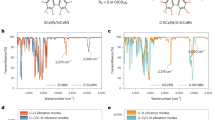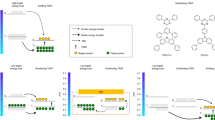Abstract
Organic light-emitting diodes (OLEDs) employing thermally activated delayed fluorescence (TADF) have emerged as cheaper alternatives to high-performance phosphorescent OLEDs with noble-metal-based dopants. However, the efficiencies of blue TADF OLEDs are still low at high luminance, limiting full-colour display. Here, we report a blue OLED containing a 9,10-dihydroacridine/diphenylsulphone derivative that has a comparable performance to today's best phosphorescent OLEDs. The device offers an external quantum efficiency of 19.5% and reduced efficiency roll-off characteristics at high luminance. Through computational simulation, we identified six pretwisted intramolecular charge-transfer (CT) molecules with small singlet–triplet CT state splitting but different energy relationships between 3CT and locally excited triplet (3LE) states. Systematic comparison of their excited-state dynamics revealed that CT molecules with a large twist angle can emit efficient and short-lifetime (a few microseconds) TADF when the emission peak energy is high enough and the 3LE state is higher than the 3CT state.
This is a preview of subscription content, access via your institution
Access options
Subscribe to this journal
Receive 12 print issues and online access
$209.00 per year
only $17.42 per issue
Buy this article
- Purchase on SpringerLink
- Instant access to full article PDF
Prices may be subject to local taxes which are calculated during checkout



Similar content being viewed by others
References
Adachi, C., Baldo, M. A., Thompson, M. E. & Forrest, S. R. Nearly 100% internal phosphorescence efficiency in an organic light emitting device. J. Appl. Phys. 90, 5048–5051 (2001).
Yersin, H. & Finkenzeller, W. J. (ed. Yersin, H.) in Highly Efficient OLEDs with Phosphorescent Materials Ch. 1 (Wiley-VCH, 2008).
Ganzorig, C. & Fujihira, M. A possible mechanism for enhanced electrofluorescence emission through triplet–triplet annihilation in organic electroluminescent devices. Appl. Phys. Lett. 81, 3137–3139 (2002).
Kondakov, D. Y., Pawlik, T. D., Hatwar, T. K. & Spindler, J. P. Triplet annihilation exceeding spin statistical limit in highly efficient fluorescent organic light-emitting diodes. J. Appl. Phys. 106, 124510 (2009).
Fukagawa, H. et al. Anthracene derivatives as efficient emitting hosts for blue organic light-emitting diodes utilizing triplet–triplet annihilation. Org. Electron. 13, 1197–1203 (2012).
Zhang, Q. et al. Highly efficient electroluminescence from green-light-emitting electrochemical cells based on CuI complexes. Adv. Funct. Mater. 16, 1203–1208 (2006).
Tsuboyama, A. et al. Photophysical properties of highly luminescent copper(I) halide complexes chelated with 1,2-bis(diphenylphosphino)benzene. Inorg. Chem. 46, 1992–2001 (2007).
Deaton, J. C. et al. E-type delayed fluorescence of a phosphine-supported Cu2(μ-NAr2)2 diamond core: harvesting singlet and triplet excitons in OLEDs. J. Am. Chem. Soc. 132, 9499–9508 (2010).
Hashimoto, M. et al. Highly efficient green organic light-emitting diodes containing luminescent three-coordinate copper(I) complexes. J. Am. Chem. Soc. 133, 10348–10351 (2011).
Hsu, C.-W. et al. Systematic investigation of the metal–structure–photophysics relationship of emissive d10-complexes of group 11 elements: the prospect of application in organic light emitting devices. J. Am. Chem. Soc. 133, 12085–12099 (2011).
Zhang, Q. et al. Triplet exciton confinement in green organic light-emitting diodes containing luminescent charge-transfer Cu(I) complexes. Adv. Funct. Mater. 22, 2327–2336 (2012).
Kirchhoff, J. R. et al. Temperature dependence of luminescence from Cu(NN)2+ systems in fluid solution. Evidence for the participation of two excited states. Inorg. Chem. 22, 2380–2384 (1983).
Lavie-Cambot, A. et al. Improving the photophysical properties of copper(I) bis(phenanthroline) complexes. Coord. Chem. Rev. 252, 2572–2584 (2008).
Yersin, H., Rausch, A. F., Czerwieniec, R., Hofbeck, T. & Fischer, T. The triplet state of organo-transition metal compounds. Triplet harvesting and singlet harvesting for efficient OLEDs. Coord. Chem. Rev. 255, 2622–2652 (2011).
Klessinger, M. & Michl, J. Excited States and Photochemistry of Organic Molecules (VCH, 1995).
Endo, A. et al. Efficient up-conversion of triplet excitons into a singlet state and its application for organic light emitting diodes. Appl. Phys. Lett. 98, 083302 (2011).
Goushi, K., Yoshida, K., Sato, K. & Adachi, C. Organic light-emitting diodes employing efficient reverse intersystem crossing for triplet-to-singlet state conversion. Nature Photon. 6, 253–258 (2012).
Nakagawa, T., Ku, S.-Y., Wong, K.-T. & Adachi C. Electroluminescence based on thermally activated delayed fluorescence generated by a spirobifluorene donor–acceptor structure. Chem. Commun. 48, 9580–9582 (2012).
Méhes, G., Nomura, H., Zhang, Q., Nakagawa, T. & Adachi, C. Enhanced electroluminescence efficiency in a spiro-acridine derivative through thermally activated delayed fluorescence. Angew. Chem. Int. Ed. 51, 11311–11315 (2012).
Lee, S. Y., Yasuda, T., Nomura, H. & Adachi, C. High-efficiency organic light-emitting diodes utilizing thermally activated delayed fluorescence from triazine-based donor–acceptor hybrid molecules. Appl. Phys. Lett. 101, 093306 (2012).
Zhang, Q. et al. Design of efficient thermally activated delayed fluorescence materials for pure blue organic light emitting diodes. J. Am. Chem. Soc. 134, 14706–14709 (2012).
Tanaka, H., Shizu, K., Miyazaki, H. & Adachi, C. Efficient green thermally activated delayed fluorescence (TADF) from a phenoxazine–triphenyltriazine (PXZ–TRZ) derivative. Chem. Commun. 48, 11392–11394 (2012).
Uoyama, H., Goushi, K., Shizu, K., Nomura, H. & Adachi, C. Highly efficient organic light-emitting diodes from delayed fluorescence. Nature 492, 234–238 (2012).
Li, J. et al. Highly efficient organic light-emitting diode based on a hidden thermally activated delayed fluorescence channel in a heptazine derivative. Adv. Mater. 25, 3319–3323 (2013).
Lee, J. et al. Oxadiazole- and triazole-based highly-efficient thermally activated delayed fluorescence emitters for organic light-emitting diodes. J. Mater. Chem. C 1, 4599–4604 (2013).
Wu, S. et al. High-efficiency deep-blue organic light-emitting diodes based on a thermally activated delayed fluorescence emitter. J. Mater. Chem. C 2, 421–424 (2014).
Rettig, W. & Chandross, E. A. Dual fluorescence of 4,4′-dimethylamino- and 4,4′-diaminophenyl sulfone. Consequences of d-orbital participation in the intramolecular charge separation process. J. Am. Chem. Soc. 107, 5617–5624 (1985).
Grabowski, Z. R., Rotkiewicz, K. & Rettig, W. Structural changes accompanying intramolecular electron transfer: focus on twisted intramolecular charge-transfer states and structures. Chem. Rev. 103, 3899–4031 (2003).
Dias, F. B. et al. Triplet harvesting with 100% efficiency by way of thermally activated delayed fluorescence in charge transfer OLED emitters. Adv. Mater. 25, 3707–3714 (2013).
Huang, S. et al. Computational prediction for singlet- and triplet-transition energies of charge-transfer compounds. J. Chem. Theory Comput. 9, 3872–3877 (2013).
Becke, A. D. Density-functional thermochemistry. III. The role of exact exchange. J. Chem. Phys. 98, 5648–5652 (1993).
Bolton, O., Lee, K., Kim, H.-J., Lin, K. Y. & Kim, J. Activating efficient phosphorescence from purely organic materials by crystal design. Nature Chem. 3, 205–210 (2011).
Smith, C. S. & Mann, K. R. Exceptionally long-lived luminescence from [Cu(I)(isocyanide)2(phen)]+ complexes in nanoporous crystals enables remarkable oxygen gas sensing. J. Am. Chem. Soc. 134, 8786–8789 (2012).
Yarnell, J. E., Deaton, J. C., McCusker, C. E. & Castellano, F. N. Bidirectional ‘ping-pong’ energy transfer and 3000-fold lifetime enhancement in a Re(I) charge transfer complex. Inorg. Chem. 50, 7820–7830 (2011).
Wardle, B. Principles and Applications of Photochemistry 175 (Wiley, 2009).
Han, C. et al. A simple phosphine–oxide host with a multi-insulating structure: high triplet energy level for efficient blue electrophosphorescence. Chem. Eur. J. 17, 5800–5803 (2011).
Giebink, N. C. & Forrest, S. R. Quantum efficiency roll-off at high brightness in fluorescent and phosphorescent organic light emitting diodes. Phys. Rev. B 77, 235215 (2008).
Jeon, S. O., Jang, S. E., Son, H. S. & Lee, J. Y. External quantum efficiency above 20% in deep blue phosphorescent organic light-emitting diodes. Adv. Mater. 23, 1436–1441 (2011).
Hang, X.-C., Fleetham, T., Turner, E., Brooks, J. & Li, J. Highly efficient blue-emitting cyclometalated platinum(II) complexes by judicious molecular design. Angew. Chem. Int. Ed. 52, 6753–6756 (2013).
Lee, S. et al. Deep-blue phosphorescence from perfluoro carbonyl-substituted iridium complexes. J. Am. Chem. Soc. 135, 14321–14328 (2013).
Yook, K. S. & Lee, J. Y. Organic materials for deep blue phosphorescent organic light-emitting diodes. Adv. Mater. 24, 3169–3190 (2012).
Xiao, L. et al. Recent progresses on materials for electrophosphorescent organic light-emitting devices. Adv. Mater. 23, 926–952 (2011).
Peng, T. et al. Highly efficient phosphorescent OLEDs with host-independent and concentration-insensitive properties based on a bipolar iridium complex. J. Mater. Chem. C 1, 2920–2926 (2013).
Acknowledgements
This work was supported by a Grant-in-Aid from the Funding Program for World-Leading Innovative R&D on Science and Technology (FIRST) and the International Institute for Carbon Neutral Energy Research (WPI-I2CNER) sponsored by MEXT. The authors thank J.-L. Brédas, M. Kotani and K. Tokumaru for stimulating discussions regarding this work. The authors also thank W. J. Potscavage Jr for assistance with preparation of this manuscript.
Author information
Authors and Affiliations
Contributions
Q.Z. designed the molecules. B.L. measured photoluminescence and electroluminescence characteristics. S.H. performed the computational experiments. Q.Z and H.N. synthesized the compounds. H.T. provided experimental support and suggestions. Q.Z. and C.A. wrote the manuscript.
Corresponding author
Ethics declarations
Competing interests
The authors declare no competing financial interests.
Supplementary information
Supplementary information
Supplementary information (PDF 1494 kb)
Rights and permissions
About this article
Cite this article
Zhang, Q., Li, B., Huang, S. et al. Efficient blue organic light-emitting diodes employing thermally activated delayed fluorescence. Nature Photon 8, 326–332 (2014). https://doi.org/10.1038/nphoton.2014.12
Received:
Accepted:
Published:
Issue Date:
DOI: https://doi.org/10.1038/nphoton.2014.12



